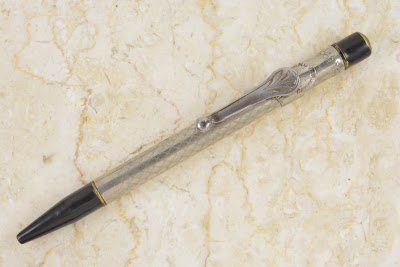This article has been edited and included in The Leadhead's Pencil Blog Volume 5; copies are available print on demand through Amazon here, and I offer an ebook version in pdf format at the Legendary Lead Company here.
If you don't want the book but you enjoy this article, please consider supporting the Blog project here.
Every year there’s an auction at the Raleigh Pen Show (also known as the Triangle Pen Show), and this year’s affair featured a few lots of pencils that I found interesting during the preview. One lot featured a dozen or so early metal pencils from the first couple decades of the last century, and Joe Nemecek said he was going to bid on that bunch because there was a Hutcheon in there he was interested in.
I sat back and let Joe have at it – but as the bidding heated up, he dropped out at what I considered still a low price for what was in that bunch. So I jumped in . . . not for the Hutcheon so much, but for this one:
Since I’m a member of Newark Lodge Number 391 of the Benevolent and Protective Order of Elks (BPOE), whenever I find a nice early piece of memorabilia from one of my furry animal clubs I’m a happy camper. I couldn’t really tell what that pink paper rolled around the barrel was, but I was hoping it was an instruction sheet for the pencil. . .
When I flattened it out, though, it turned out to be a blank Elks membership card, complete with instructions regarding the proper use of “Royal Glue,” snapping rubber bands and slipping brass collars down to the center
I think I’m missing something here. These just look like random words to me. However, with the card slipped off the barrel of the pencil, it made it easier to notice something a little odd about the end of that pencil:
That extra long tip twists to advance and retract the lead, which made me wonder what happens if you unscrew the crown . . . and now for something completely different:
Now that’s
really unusual. It’s essentially a leadholder with a little screw drive mechanism replacing what would ordinarily be a stick of lead. That had me looking more closely at the barrel to see if there were any more clues, and there was one, imprinted above the Elks emblem:
“Pat. Dec. 31, 12.” That was a date I wasn’t familiar with, but it didn’t take long to find a pencil patent issued on that date in
American Writing Instrument Patents Vol. 2: 1911-1945 (brief commercial announcement . . . copies are still available at
http://www.legendaryleadcompany.com/store/p15/American_Writing_Instrument_Patents_Volume_2%3A_1911-1945.html):
George V. Orban and Bogumil Silberstein of New York, New York applied for patent number 1,049,137 on January 24, 1912, but when I looked at the Orban/Silberstein patent, there’s something wrong here . . .
The drawings and the description show a plunger backed by a spring which scoots the lead forward when the entire mechanism is pushed inward ... and my pencil has a screw drive mechanism. This isn’t my pencil.
But I do have one other patent listed in my book and filed on December 31, 1912 . . . and it isn’t for a pencil:
Alonzo Bunt Scott of Fairmont, West Virginia applied for a patent for his “card-case attachment for pencils” on April 9, 1912, and it was issued December 31, 1912 as patent number 1,049,275.
And then the lights came on. Remember those curious instructions? Look what’s at the end:
Whaddaya know. That also explains that loose metal ring at the top of the mechanism, which I thought was broken. It’s actually a retaining ring (the "brass collar" referred to in the instructions) so that when your card is rolled up, it holds it tightly wound so that the barrel slips easily slips over it. I wound it tightly, but as I’m fresh out of “Royal Glue,” I didn’t attach it:
The patent drawings don’t show that retaining ring - instead, it shows a “card clamping ring” detailed at figure 4. Note also that the barrel is secured to the inner workings by threading at the top end, rather than by a threaded bushing closer to the nose. These differences were explained when I turned to the “patents by inventor” section of my book, where I’ve listed a second patent issued to Alonzo for an improved version of his pencil as number 1,297,017, applied for on October 18, 1918 and issued March 11, 1919:
Scott’s “Patent Card-Case Pencil” must have enjoyed some measure of commercial success. I’ve found three advertisements for his invention. The earliest, attributed to 1918, was posted in a silver forum (
http://925-1000.com/forum/viewtopic.php?t=35655&start=20) by “dognose.” I haven’t been able to find the original:
In August, 1922, Scott advertised his pencil in
Golfers Magazine as a scoring attachment; I’m not sure how this would work; at least with my example, the pencil is attached to the card, so when the card is extracted, you’d need a second pencil to write on it . . .
In late 1922, they were also advertised in
The Jewelers’ Circular:
Note that in all these advertisements, the pencil doesn’t appear to come out with the attachment - that must especially be true with the golf scoring card attachment. For that reason, I tend to think my example is a transitional model, made sometime between the 1912 and 1919 patents.
Alonzo Bunt Scott was an interesting character. In addition to his jewelry business, optometry practice (including service on West Virginia’s Board of Optometry) and pencil patents, he received patents for an attachment for suspenders (number 1,245,043) in 1917, for a “golf putting device” (number 1,546,260) in 1925, and two for golf putting boxes (numbers 1,473,051 and 1,614.399) in 1923 and 1927. By 1936,
Rotarian magazine announced that members interested in gardening should contact Alonzo as an authority on prize dahlias.


















































